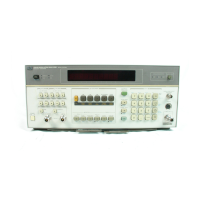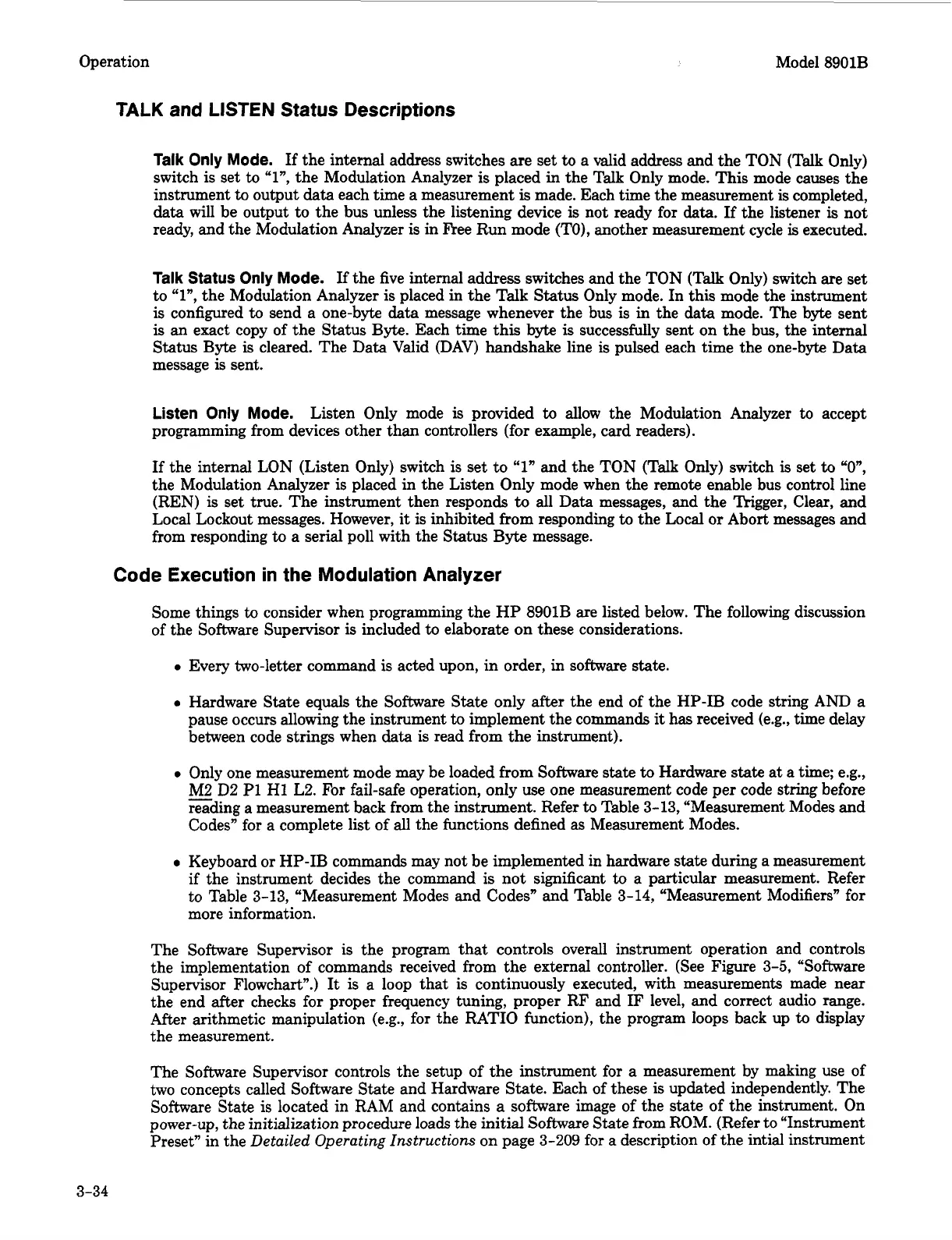Operation Model 8901B
TALK
and
LISTEN
Status Descriptions
Talk
Only
Mode.
If
the internal address switches are set
to
a valid address and the TON (Talk Only)
switch is set
to
“l”,
the Modulation Analyzer
is
placed in the Talk Only mode. This mode causes the
instrument
to
output
data
each time a measurement
is
made. Each time the measurement
is
completed,
data will be output to the bus unless the listening device
is
not ready for
data.
If
the listener
is
not
ready, and the Modulation Analyzer
is
in Flee Run mode
(TO),
another measurement cycle
is
executed.
Talk Status
Only
Mode.
If
the five internal address switches and the TON (Talk Only) switch are set
to “l”, the Modulation Analyzer is placed in the Talk Status Only mode. In this mode the instrument
is
configured
to
send a one-byte data message whenever the bus
is
in
the
data
mode. The byte sent
is
an exact copy of the Status Byte. Each time this byte
is
successfully sent on the bus, the internal
Status Byte is cleared. The Data Valid (DAV) handshake line is pulsed each time the one-byte Data
message is sent.
Listen Only
Mode.
Listen Only mode is provided
to
allow the Modulation Analyzer
to
accept
programming from devices other than controllers (for example, card readers).
If the internal LON (Listen Only) switch is set to
“1”
and the TON (Talk Only) switch
is
set
to
“0”,
the Modulation Analyzer is placed in the Listen Only mode when the remote enable bus control line
(REN)
is
set true. The instrument then responds
to
all
Data messages, and the Trigger, Clear, and
Local Lockout messages. However, it
is
inhibited from responding
to
the Local
or
Abort messages and
from responding
to
a
serial poll with the Status Byte message.
Code Execution in the Modulation Analyzer
Some things
to
consider when programming the HP 8901B are listed below. The following discussion
of the Software Supervisor
is
included
to
elaborate on these considerations.
0
Every two-letter command is acted upon, in order, in sohare
state.
0
Hardware State equals the Software State only after the end of the HP-IB code string
AND
a
pause occurs allowing the instrument
to
implement the commands
it
has received (e.g., time delay
between code strings when data
is
read from the instrument).
0
Only one measurement mode may be loaded from Software state
to
Hardware state at
a
time; e.g.,
-
M2 D2
P1
H1
L2.
For
fail-safe operation, only use one measurement code per code string before
reading a measurement back from the instrument. Refer
to
Table 3-13, “Measurement Modes and
Codes” for a complete list of
all
the functions defined
as
Measurement Modes.
Keyboard
or
HP-IB commands may not be implemented in hardware state during a measurement
if
the instrument decides the command
is
not significant
to
a particular measurement. Refer
to
Table 3-13, “Measurement Modes and Codes” and Table 3-14, “Measurement Modifiers” for
more information.
The Software Supervisor is the program that controls overall instrument operation and controls
the implementation of commands received from the external controller. (See Figure 3-5, “Software
Supervisor Flowchart”.) It is a loop that
is
continuously executed, with measurements made near
the end after checks for proper frequency tuning, proper RF and
IF
level, and correct audio range.
After
arithmetic manipulation (e.g., for the
RATIO
function), the program loops back up
to
display
the measurement.
The Software Supervisor controls the setup of the instrument for a measurement by making use of
two concepts called Software State and Hardware State. Each of these
is
updated independently. The
Software State is located in RAM and contains
a
software image of the state
of
the instrument. On
power-up, the initialization procedure loads the initial Software
State
from
ROM.
(Refer to “Instrument
Preset” in the
Detailed Operating Instructions
on page 3-209 for a description of the intial instrument
3-34

